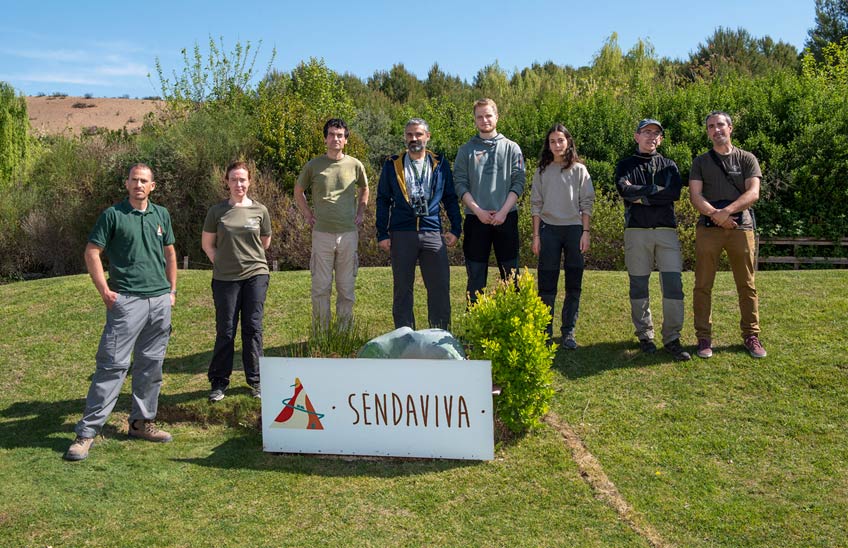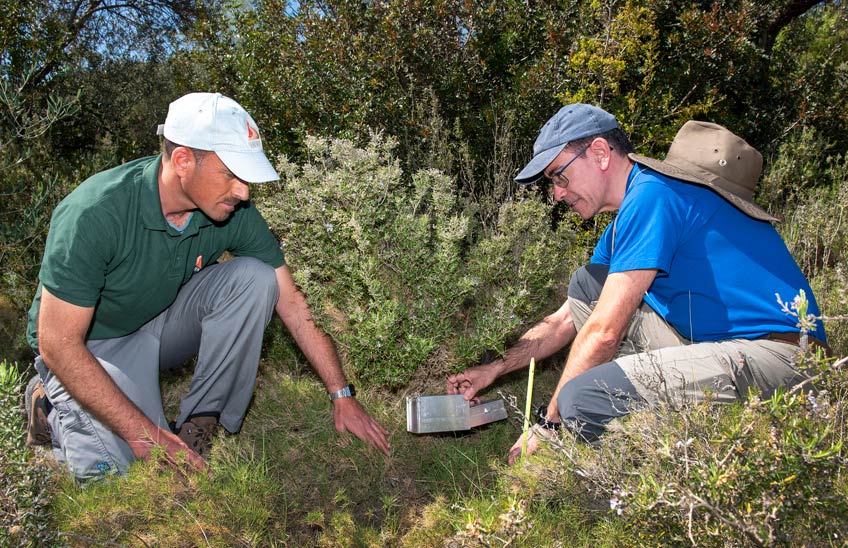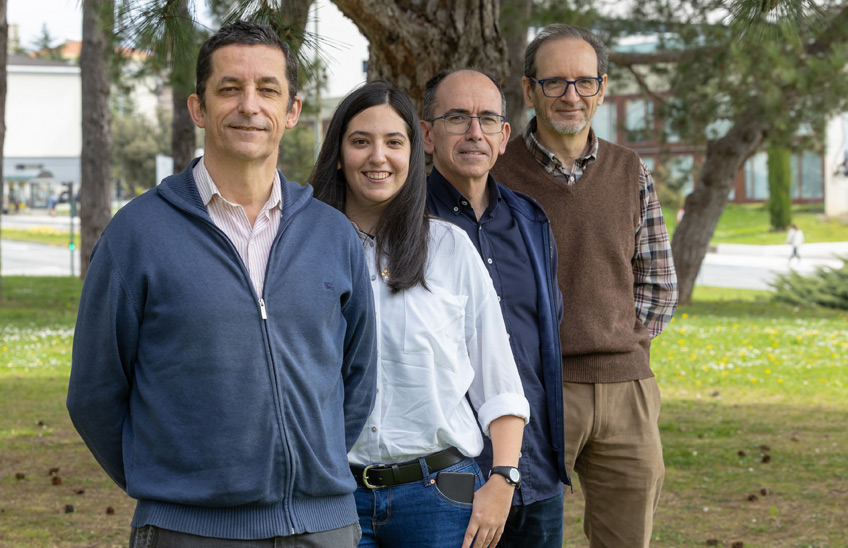ZooNaGreen' analyzes the native wild species living in Sendaviva to determine whether it has become a reservoir of biodiversity.
The Navarre park coordinates the environmental project , at partnership with the Aranzadi Science Society, the University of Navarra and the University of the Basque Country, where species of pollinating insects, birds, micromammals and mesomammals are studied.

FotoCedida/Fromleft to right, Efrén Fernández (Sendaviva); Beatriz Díaz and Alberto de Castro (Aranzadi Science Society); Jabi Zabala, Raúl Barbarin and Nerea Fernández (University of the Basque Country); David Galicia (University of Navarra); and Xabier Esparza (Aranzadi Science Society).
16 | 05 | 2023
Sendaviva, the Navarre Adventure and Fun park, coordinates and finances 'ZooNaGreen' during 2023, an environmental project where an analysis of the biodiversity of species of pollinating insects, birds, micromammals and mesomammals will be carried out, at partnership with the Aranzadi Science Society, the University of Navarra and the University of the Basque Country.
The goal of project is to demonstrate that Sendaviva, being an enclosure in which the fauna and flora are respected, cared for and enhanced through planting, maintenance of vegetation and the creation of water points, has become a reservoir of biodiversity. And for this, through this project the wild species found in this environment will be analyzed.
ZooNaGreen' will host, throughout 2023, four groups of work that are already carrying out samplings from April to July. The entomological (pollinating insects) and ornithological (birds) studies are being carried out by the Aranzadi Science Society; the University of Navarra is carrying out the micromammals study. For its part, the University of the Basque Country will study the group of mesomammals, whose sampling dates in this case will be developed in two phases. The first from June to August and the second from December to February.
The general coordinator of project is Efren Fernandez, coordinator Projects department Sendaviva Environment . Researchers Beatriz Díaz and Alberto de Castro, from the Aranzadi Science Society, will analyze the group of pollinating insects; Xabier Esparza and Juan Arizaga, also from the Aranzadi Science Society, will be in charge of the study of ornithology; David Galicia, from the University of Navarra, will study the group of micromammals; and Jabi Zabala, from the department of Zoology and Animal Cell Biology of the University of the Basque Country, will analyze the group of mesomammals.

Pollinating insects and birds
The Aranzadi Science Society will carry out an inventory of the existing species in the park, as well as compare the issue of species both in the park and its surroundings. One of the groups of interest are pollinating insects for the beneficial services they provide in crop fertility and in maintaining the diversity of flowering plants, especially considering the location of Sendaviva in a predominantly agricultural environment.
Thus, the department of Entomology of the entity began the study of pollinating insects in mid-April and will conclude in mid-July, carrying out six sampling conference . The method employee will be through the placement of about thirty traps of chromatic attraction (yellow, white and blue) and using as indicators, mainly bees and flower flies, recognized as the main groups of pollinating animals, although other groups of pollinating insects may also be included.
In addition to helping to reduce the lack of knowledge about these insects in Navarra, this study will also serve to evaluate the park's contribution in terms of pollinator diversity with respect to its surroundings and its potential as a reservoir of biodiversity.
Similarly, the Aranzadi Science Society is also developing the ornithological study, which focuses on the community of breeding birds in the area, and will be used as a basis for conducting censuses through transect monitoring and observation of specimens.
Nesting bird populations are the most interesting from the conservation point of view and, therefore, will be a priority for monitoring, since they are formed by individuals that will reproduce and, consequently, ensure the offspring and future viability of the populations.
During the analysis, a total of 80 transects will be carried out, evenly distributed throughout the park and its immediate surroundings. Within each zone there will be subdivisions of the main habitats: forest, shrubland, landscaped landscape and crops. Each transect will be walked twice, at different periods, to minimize bias effects caused by different conditions.
Sampling will be carried out in two periods, one between mid-April and May, aimed at sampling resident and pre-Saharan summer species; and the second, between mid-May and June, to study trans-Saharan summer species.
In parallel to the censuses, the presence of all the species detected in the area will be noted, which will be especially useful for the scarcer species or those with a lower detectability, as may be the case of some raptors.
Micromammals and mesomammals
The University of Navarra is studying micromammals, species that are the basis of the diet of many carnivores and predators, in turn, of many invertebrates. For their analysis, they are going to establish a pair of monitoring stations with two plots each in environments inside and outside the park, where micromammal populations are present.
Each of the plots is sampled for three nights, with a daily effort of between 25 and 50 live traps. Captured animals are identified, measured and released back into the environment with a mark that allows recording their capture history throughout the campaign.
The University of the Basque Country is conducting the analysis of mesomammals, goal to determine the composition of the medium-sized mammal community and their relative activity within the park compared to the surrounding forests. The presence of mesomammals is indicative of the existence of food and shelter for them in the park environment.
The analysis sampled the presence and relative activity of the species in forest areas inside Sendaviva and in other areas of reference letter outside them using a total of 30 photo-trapping cameras, 15 of them in the forests of each environment.
A minimum of three zones will be sampled in Sendaviva and another two, at least, in surrounding forests, within a radius of six kilometers. The cameras will be kept in each area for two three-month periods. The periods are next summer (between June and August) and next winter (from December to February).
The images obtained with the photo-trapping cameras will be analyzed to determine and compare the composition of the mesomammal community outside and inside the park, to determine the activity patterns in each environment and to approximate and compare the frequency of use of each of the environments.


